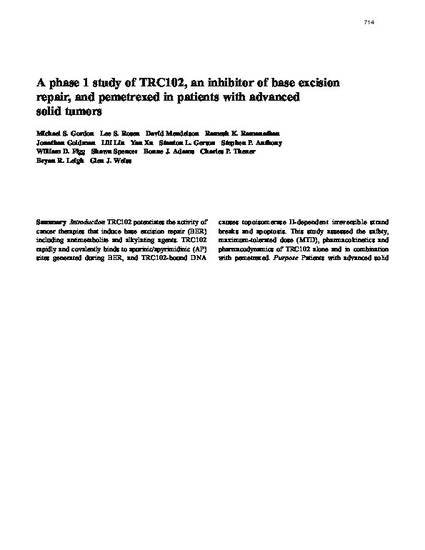
Introduction TRC102 potentiates the activity of cancer therapies that induce base excision repair (BER) including antimetabolite and alkylating agents. TRC102 rapidly and covalently binds to apurinic/apyrimidinic (AP) sites generated during BER, and TRC102-bound DNA causes topoisomerase II-dependent irreversible strand breaks and apoptosis. This study assessed the safety, maximum-tolerated dose (MTD), pharmacokinetics and pharmacodynamics of TRC102 alone and in combination with pemetrexed. Purpose Patients with advanced solid tumors received oral TRC102 daily for 4 days. Two weeks later, patients began standard-dose pemetrexed on day 1 in combination with oral TRC102 on days 1 to 4. The pemetrexed-TRC102 combination was repeated every 3 weeks until disease progression. Methods Twenty-eight patients were treated with TRC102 at 15, 30, 60 or 100 mg/m2/d. The MTD was exceeded at 100 mg/m2/d due to grade 3 anemia in 50 % of patients. TRC102 exposure increased in proportion to dose with a mean t1/2 of 28 h. A pharmacodynamic assay confirmed that TRC102 binds to pemetrexed-induced AP sites at all doses studied. Stable disease or better was achieved in 15 of 25 patients evaluable for response (60 %), including one patient with recurrent metastatic oropharyngeal carcinoma that expressed high levels of thymidylate synthase, who achieved a partial response and was progression free for 14 months. Conclusions When administered with pemetrexed, the maximum tolerated dose of oral TRC102 is 60 mg/m2/d for 4 days. Randomized controlled studies are planned to evaluate the clinical benefit of adding TRC102 to pemetrexed and other agents that induce BER. © 2012 Springer Science+Business Media, LLC.
Available at: http://works.bepress.com/shawn-spencer/33/
